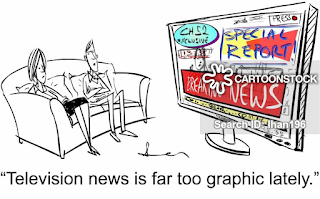Valeria Santizo
vs178718@ohio.edu
Have you ever looked at a graphic image and told yourself, “I
wish I hadn’t seen that,”? I get it, sometimes the graphic images the media
shows have a way of making us see a reality we are foreign to. Setting boundaries
for graphic images and what the public should or should not see is a debatable
topic. However, sometimes to get your point across people need to see the truth
regardless if it is too graphic or not. I believe the media should be free to
publish graphic images if an only if they are not altered or photo-shopped to
appear different than the original image.
 |
| https://www.cartoonstock.com/cartoonview.asp?catref=lhan196 |
I believe the media should be able to publish graphic images
because sometimes it is the only way to get people to react. Take for example
the story of Emmitt Till. Emmitt was a 14-year-old African-American boy from
Chicago who went to visit family in Money, Mississippi. While he was there, he was tortured,
murdered, and thrown into the Tallahatchie river for allegedly whistling at a
white woman who was married to one of the murderers. When authorities found
Emmitt’s body it was badly disfigured and unrecognizable. His body was sent
back to Chicago where his mother, Mamie Till, held an open casket funeral. She
decided she wanted to show the world the results of this hate crime. Mamie was
quoted saying, "let
the world see what has happened, because there is no way I could describe this.
And I needed somebody to help me tell what it was like." The casket was
open for 5 days at Roberts Temple Church of God and thousands of people came to
see the body including journalists. When Emmitt Till’s picture was shown all
over newspapers, people were outraged especially after the two men who murdered
Till were set free. One woman in particular was so outraged that when she was
asked to give up her seat on a bus to a white man, she refused galvanizing the
Civil Rights Movement in 1955. Her name was Rosa Parks, and this is what
started the Montgomery Bus Boycott. When asked why she refused to give up her
seat Parks stated, "I thought about
Emmett Till, and I couldn't go back to the back of the bus.” Because of stories
like this I think it is important to show the world what people are capable of
even if it makes us uncomfortable.
In today’s world people debate that viewers are desensitized
by graphic images in the media, I beg to differ. People still get offended when
graphic images from war are shown in the news. One specific event was the
bombing in Gaza in 2014. Images circulated the internet of dead children lying face
down on the sandy beaches of Gaza. There is a fear reporters have of offending
people or crossing the line with these images. However, I think imagery like
this is important and to best describe why I have to quote war photographer,
Christoph Bangert, “How can we refuse to
acknowledge a mere representation—a picture—of a horrific event, while other
people are forced to live through the horrific event itself?” (Bangert, 2014). I
completely agree with Bangert, we need to see what is happening in the world
around us and be aware of the consequences that come with decisions people make.
No comments:
Post a Comment